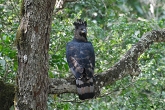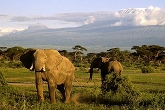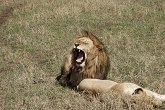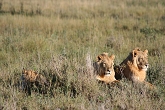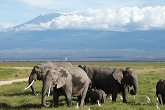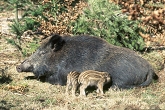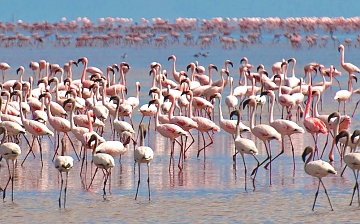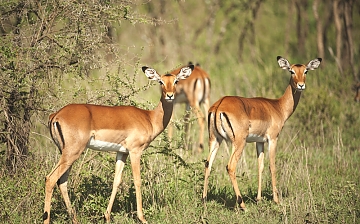Lake Nakuru National Park
Established in 1961, Lake Nakuru National Park is an area of grassland, bush and rocky cliffs. Hundreds of birds and mammals have made Lake Nakuru National Park their home. Waterbucks, warthogs and buffaloes are common at the water's edge. Between three and four hundred buffalo inhabit the park and the best time to see them is at dusk or dawn in the forested area.
Established in 1961, Lake Nakuru National Park is an area of grassland, bush and rocky cliffs. Hundreds of birds and mammals have made Lake Nakuru National Park their home. Waterbucks, warthogs and buffaloes are common at the water's edge. Between three and four hundred buffalo inhabit the park and the best time to see them is at dusk or dawn in the forested area.Lake Nakuru is world famous for the multitudes of bright pink flamingoes whose numbers often total more than two million although these numbers are diminishing. The best place to watch the flamingoes is from Baboon Cliff. Lake Nakuru became Kenya's first bird sanctuary in 1960 to protect the estimated 450 species and then it was upgraded to National Park status in 1968
Lions and leopards are often seen as well as large sized python snakes, the cliffs make an ideal home.
Lake Nakuru National Park, which surrounds the lake, was enlarged to provide a sanctuary for the white and black rhinos. This healthy population of rhinos means that visitors will most likely come across a few of these endangered animals.
About 550 different plant species are found within Lake Nakuru National Park including the biggest euphorbia forest in Africa. The euphorbia plant is also known as the candelabra cactus.
Flamingoes & Birds:- The Park is the home to over a million flamingoes. Fleets of Lesser and Greater Flamingoes line the shores of Lake Nakuru giving it a pinkish appearance. Besides flamingoes, Lake Nakuru is home to other water birds including a variety of terrestrial birds numbering about 450 species in total.
Mammals: 56 different species of mammals have been identified in Nakuru Park, including black and white rhinos, Rothschild's giraffes, cape buffaloes, Deffassa waterbucks, Thomson's and grant�s gazelles, impalas, lions, leopards, warthogs, olive baboons, black backed jackal, reedbucks, dik diks, elands,
Unique vegetation: About 550 different plant species are found in Lake Nakuru National Park. Lake Nakuru boasts of the largest Euphorbia cnadlebrum forest in Africa, Picturesque landscape and yellow acacia woodland.
Reptiles: A large number of reptiles inhabit Lake Nakuru including the python and tortoise.







